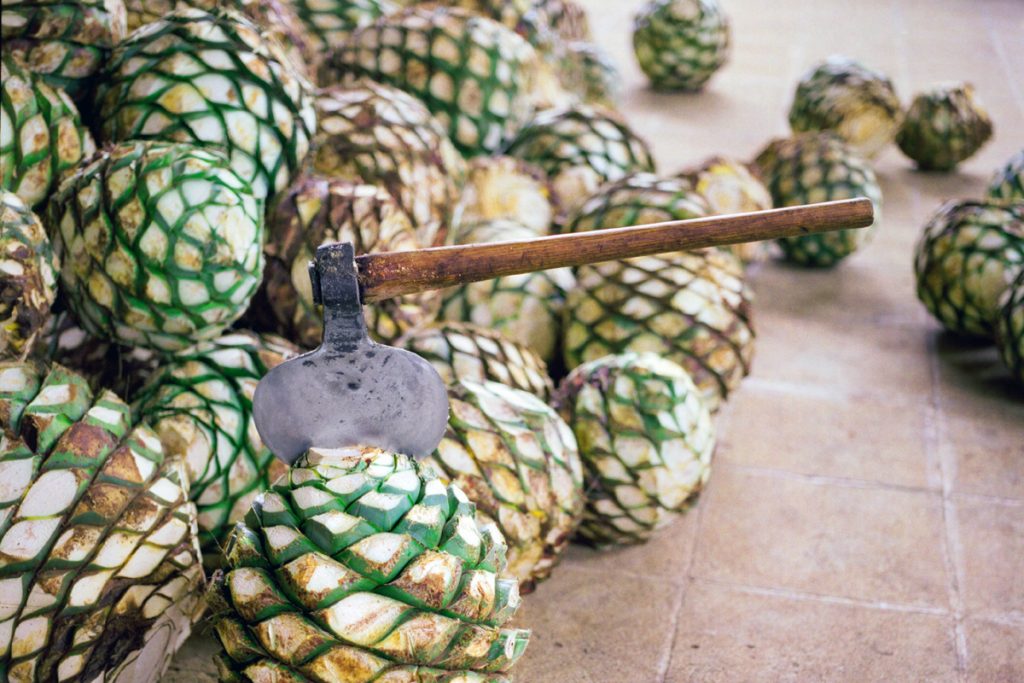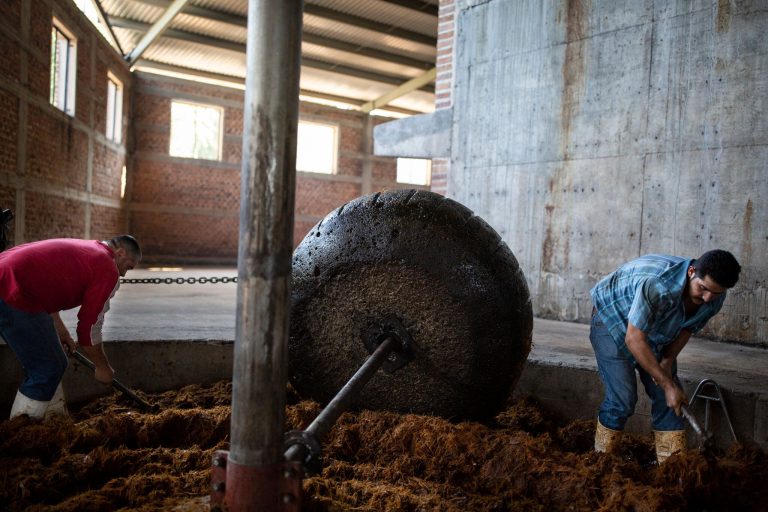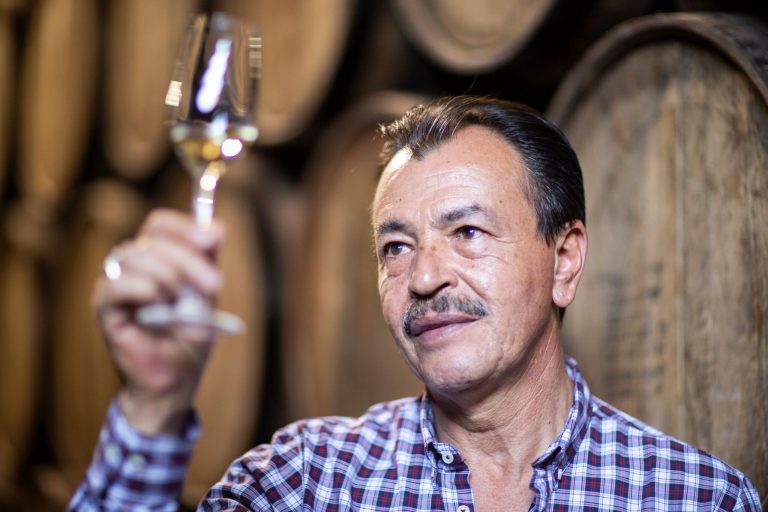El Tesoro Tequila’s Farm and Distillery, Arandas
Exploring the Jalisco region’s agave treasures with Master Distiller Carlos Camarena

“Historically, these plants can provide people with shelter, food, spirits, of course— tools with their needles to sow. Everything!” Carlos Camarena tells us, standing on the red clay earth amid a field of agaves. He goes on to explain how the succulent’s dried leaves are still used in the region for roofing and building walls, its quioxotes (long pistols) for fences, and fibers used for clothing and rope. “I love these plants,” he says, “The agave is so magnificent, what is there not to love?”
Not only the Master Distiller of El Tesoro and its parent La Alteña Distillery, Camarena is the grandson of Don Felipe Camarena, who founded La Alteña back in 1937. While it was his grandfather who built this distillery, the Camarena family actually goes back five generations as tequileros; the love is deep. That is but only one of the reasons why the family chose their halo El Tesoro brand (now owned by Beam Suntory), which means “The Treasure” in Spanish, to be single estate—meaning 100% of the agave plants used in El Tesoro tequila are grown here on their 500-hectare Arandas farm in Mexico’s Jalisco region.

“We decided to grow our own agave in order to ensure its quality. Because for 100% agave tequila we only have one raw material: agave. If you have a very good quality agave, then it becomes very simple to produce very good quality tequila. If you depend on the open market and eventually theres a shortage going on, and you cannot find first quality agaves for some reason, then you will have to buy second or third quality agaves. How can you produce good tequila out of that?” Which leads to the question: what if you do have a bad harvest? “That is one of the main reasons why I studied agriculture: in order to make sure we dont have such a thing as bad harvests of agave,” he explains.

This is an enormous commitment, because as hardy as agave is, it’s also very vulnerable to disease, drought, bugs and other looming threats. With an entire brand (and employees, extended families and others) relying on the harvest, Camarena has to protect and shepherd his soil with the combined care of a doctor, warrior, parent and scientist. Having earned his degree in Agronomy Engineering from the Universidad Autnoma Metropolitana, it is a challenge for which he is prepared. “Its not like corn where one year you dont have enough rain and therefore the corn is not good,” he explains. “With agave you have seven years to make sure that it is growing healthy, and that you can eventually harvest good quality agave.”

Camarena doesn’t just talk a big game about loving agave, he really treats his plants with a level of adoration only matched by the truly upper-tier tequileros—no pesticides are ever used; only organic materials like compost and manure. Camarena also looks out for the future of the Weber Blue species, allowing 5% of his plants to reach reproductive stage (which eliminates them from being harvested) in a joint program with the University of Mexico to create greater sexual variance in the highly recessive Weber Blue species. “If you are feeding your agave with organic, good quality elements, what can you expect?” he asks. “Good quality agaves that eventually will become good quality tequilas. To us it is as simple as that: 1 + 1 = 2. Theres no other thing.”

As we walk the fields, we stumble across a small group of workers under one of many oak trees dotting the fieldsseeking shelter from the afternoon sun. “Sorry to disturb your almuerzo!” Camarena says. “Oh no, we just finished!” calls one of the farmers, in cowboy hat, waving to Camarena. The jimadores walk back into the fields, all carrying coas—the spear-like instruments used to sheer the agave leaves—and wearing thick leather sheathes on their left legs to protect shins from stray coa strikes.

When a guide attempts moving us along to visit the distillery, Camarena quietly pleads, “Can I finish my tequila first?”—still holding a small glass filled with crystal liquid. With one quick stroke knocks back his head and finishes it. Camarena has priorities.

Soon we’re driving in Camarena’s gray pick-up truck, rollicking down the dirt trails among the fields. The agave plants here look like alien needles poking skyward from dirt. On other fields the plants are more mature, robust and plump—meaty succulent bushes carpeting the land in their particular bluish green hue as far as the horizon.

There’s about three million agaves growing in these fields, but it feels like more. Volcanic stones are cobbled high, dividing the land. Along these fences, countless oaks offer workers shade on their breaks. (On a typical day, most jimadors harvest and incredible average of 200 piñas.)
We try to adapt ourselves to Mother Nature instead of trying to modify Mother Nature to adapt to us
The Arandas farm seems to have far more trees in these fields than any of the dozen or so other ranches we’ve visited in Jalisco. “The trees were already born there, so instead of getting rid of the trees in order to get more sunlight for the agaves,” Camarena says. “We try to adapt ourselves to Mother Nature instead of trying to modify Mother Nature to adapt to us.” He notes these are the same oaks used to feed the cattle in his grandfather’s time—and they provide esoteric elements that flavor all his tequilas—so it doesn’t matter that they cost him some tillable earth. “Is it that important that I become the richest guy in the cemetery?” he asks nobody in particular.

Inside the La Altea distillery, Camarena tells us, “In our family we have two faces, but not in the way you guys think! One face is always looking to our roots, to our past. To remain loyal to what my grandfather wanted when he built this distillery: being traditional, keep on using the tahonas [two-ton volcanic stone wheels to crush the agave], keep on using the traditional ovens, keep on using open wooden fermentation baths, and very small copper stills. That is our face looking into the past: remain loyal to your roots.”
To that end, El Tesoro only uses pine and oak vats for fermentation instead of the much more common stainless steel tubsa step only four other distilleries employ (the others being Fortaleza, Patrón and Siete Leguas). While the oak tanks are the same his grandfather used, the pine ones only last 10 years so its an expensive decision. But wood helps control heat, and like all the little steps in the tequila making process, it adds up.

“And the other face is always looking into the future, asking, ‘What if?’ I am curious by nature, so it’s, ‘What if we start aging tequila in French Oak?” he says, referencing the fact that El Tesoro were the first to use the much more expensive Limousin forest-sourced oak back in 1990 for their Paradiso expression, the first tequila ever aged in ex-cognac barrels.
“We were the first crazy guys doing that,” he says. Just one of many firsts in the tequila world. In 1988 El Tesoro were the first to release a tequila that had been aged more than three years, which they dubbed at the time Muy Añejo (“very old” in Spanish). “Of course we were able to use that term for only one year and then we had to stop, because that category didn’t exist. So it was 20 years pushing in order to have a new category of tequila, and finally we have extra añejo, by definition tequila aged for over three years.”
Since then, the Camarena family have been experimenting with all sorts of finishing casks, including sherry, cognac and dessert wines. Their latest revelation, which has yet to be announced, is a tequila finished in Japanese Oak. “It is so unique,” he says, “You usually never get it out of Japan, so we are twisting some customs.” This Mizunara wood is notoriously difficult to make casks of, as the stiff timber allows a lot of alcohol to escape, making the angels share much larger than that of other types of barrels. But it is this kind of experimentation that keeps Camarena and El Tesoro one step ahead of his peers.
Shaking his head, Camarena discusses the current trend of cristalino tequilas. “These are añejo or extra añejo tequilas that are activated charcoal-filtered in order to remove all of the color and most of the flavor. To me that is not an option,” he says. “Instead we are getting into the market something that we call curado. That is blanco tequila that is infused with cooked agave in order to bring in even more agave flavor into the tequila. So instead of getting rid of flavor and color, we are adding.”

As he walks through the labyrinth of his distillery—talking about the alchemy of agaves and wood—Camarena’s love of his craft is undeniable. “We are kind of like the black sheep, thinking outside of the box, going on innovation. Going on different steps instead of following someone else’s lead,” he says. “We like to be the leaders. Everybody says we are the crazy guys of this industry, but so far everybody has followed our lead. We hope that it will continue that way.”
Inside the stone-walled aging room, it is cool and dark. Pipes dribble in natural spring water to maintain humidity; the minerals turning the stones under the pipes a rich ochre. Humid aging rooms slow the interaction with wood, so Camarena can leave his nectar aging here for years, and El Tesoro boasts one of oldest aging times across their range—their Reposado is aged between nine and 11 months, much longer than many competitors who only age for two. Their añejo is aged more than three years, making it technically an extra añejo. But they don’t label it that to avoid alienating loyalists who’ve been buying the bottle for decades. To celebrate the 80th anniversary of the distillery, this summer they will release a rare (only eight casks) expression aged a full eight years.
“That is the face that is looking into the future,” Camarena says. “Do not be afraid by somebody telling you, ‘Behind this wall there is nothing.’ I want to see whats behind that wall… I want to experience by myself.’ That is the face that is looking into the future saying, ‘What else? Where else can we go? What else can we do in order to go further into the direction of good tequila, good agave, good experience?'”

Camarena’s isn’t the passion of media-trained executive, this is the talk of a man who loves what he does, and won’t be told how to do it. He grabs a nearby bottle of Reposado and pours it into a pair of severed cow horns—the original drinking vessel of tequila. He hands them out and raises his to make a toast. “My father’s advice for making tequila was, ‘Be selfish. Do not cut corners. Do it for you.'”












